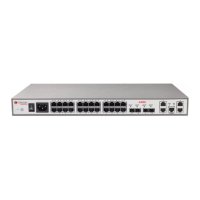A10E/A28E/A28F Configuration Guide
Self-loop: user loop in the same Ethernet interface on the same device, user network B
has loop itself, which forms self-loop;
Internal loop: the loop formed in different Ethernet interfaces on the same device, Switch
C interface 1 and interface 3 forms internal loop with the user network A;
External loop: the loop formed in the Ethernet interface of different devices, Switch A,
Switch B and Switch C form external loop with user network C.
Figure 6-13 Loopback detection networking
In Figure 6-13, assume that both Switch B and Switch connect user network interfaces enable
loop detection function. The loop detection processing mechanism for the three loop types are
as follows:
Self-loop: the No. of the interface to receive packets and that to send packet on Switch B
are the same, shut down Port 2 and remove self-loop.
Internal loop: Switch C will receive the loop detection packets issued by it and the Rx/Tx
packets interface numbers are different, then shut down Port 3 with bigger interface ID,
remove internal loop.
External loop: Switch B and Switch C will receive the loop detection packets from each
other; generally, loop detection does not deal with external loop, Switch B and Switch C
only send Trap alarm without blocking. But you can configure to block one of the
interfaces manually, such as block device interface with bigger MAC address so as to
remove external loop.
6.10.2 Preparing for configurations
Scenario
In the network, the hosts or Layer 2 devices under access devices may form loop by network
cable intentionally or involuntary. Enable loopback detection function at downlink interface
of access device to avoid the network jam formed by unlimited copies of data flow caused by
downlink interface loop. Block the loop interface once there is a loop.
Prerequisite
Configure interface physical parameters to make it Up before configuring loopback detection.
6.10.3 Default configurations of loopback detection
The default configuration of loopback detection is as below.

